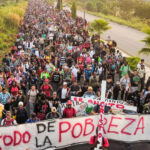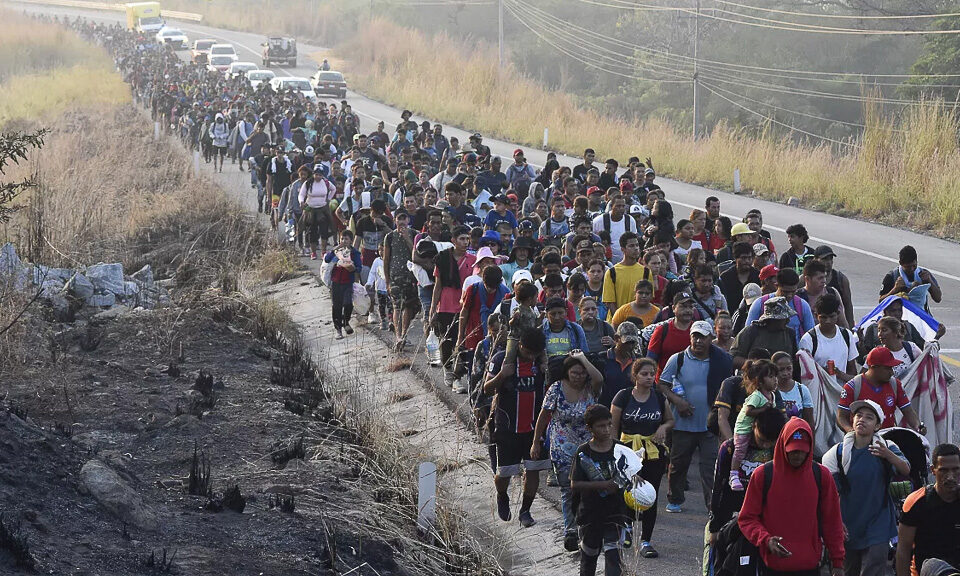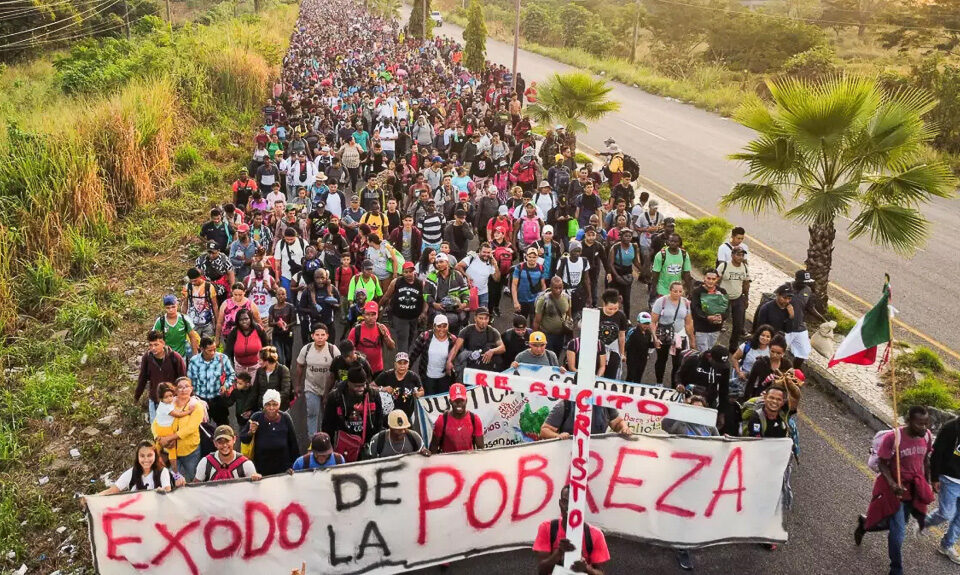
LATEST: “Poor Mexico, so far from God, so close to the United States” …
21/12/2024
ARTICLE: Seeds of Struggle. Legacies of Hope and Justice
21/12/2024If we were to keep a minute’s silence for every homicide and femicide of children and adolescents in Chiapas during the last six years, we would have to remain silent for two hours and twenty-nine minutes.
A Context of Increasing Violence
In recent years, due to its geographical location connecting the north with the south of the American continent, Chiapas has become a territory disputed by different criminal groups, which has led to an alarming increase in violence in the state to which the entire population is vulnerable. One of the most affected sectors has been children and youth. In a press conference in June 2024, the Network for the Rights of Children and Adolescents in Chiapas (REDIAS) warned: “We have no record of similar situations in terms of the amount and brutality of violence committed against this sector in Chiapas, all spheres of the lives of girls, boys and adolescents have been disrupted: daily life has been besieged by violence.”
By November 1st, REDIAS and Melel Xojobal had documented the murder of 149 girls, boys and adolescents in Chiapas between 2018 and to the present in 2024. In 2024 alone, 28 murders of girls, boys and adolescents had been recorded, in addition to eight femicides of girls and adolescent women.
On the other hand, according to official data from the National Registry of Missing Persons of the Ministry of the Interior, between January and October 31st, 2024, 663 complaints were filed in Chiapas for the disappearance of children, adolescents and young people. 208 of them are still current (without being found) and 11 of them have already been found dead.
Although the number of complaints reflects a slight reduction compared to 2023 (674 complaints were registered during the same period), the number of unsolved cases increased by 90%. As for the municipalities with the most complaints, the capital, Tuxtla Gutierrez, is in first place with 130 cases. Next is Tapachula, on the southern border, with 74 cases, of which 39 correspond to missing young women, representing 52%. In third place is San Cristobal de Las Casas, with 51 cases, of which just over half are also young women. Of the total number of missing persons, 52% are between 20 and 29 years old, 30% between 14 and 19 years old, and 19% between 0 and 13 years old.
Another situation that particularly violates the human rights of children and adolescents is the increase in forced displacement due to criminal insecurity. In a statement released in November 2024, in the framework of the celebration of the anniversary of the International Convention on the Rights of the Child, REDIAS stated that, since the beginning of the year, “at least five episodes of mass displacement have been recorded as a result of criminal violence in the Highlands, North, Frailesca and Sierra Mariscal regions. Adding the figures from the cases in January, where 3,780 people were displaced from Chicomuselo and Amatenango de la Frontera; 6,685 people from Tila in June; 105 people from Chenalho and 600 people from Amatenango de la Frontera in July, there is an estimated 11,170 people in the first half of 2024 alone.” According to these data, approximately 4,300 girls, boys and adolescents were displaced by violence in that period.
The United Nations Children’s Fund (UNICEF) has documented that the internal forced displacement of girls, boys and young people have specific and differentiated effects, particularly on their safety, their educational and recreational opportunities and access to health (physical and mental), as well as on their identity construction and sense of belonging.
Forced Recruitment: Another Phenomenon on the Rise
For more than a decade, there has been growing concern at the national level about the culture that normalizes and glorifies drug trafficking, spread through series, movies, video games, music, clothing and other items consumed daily by children and adolescents. This so-called narcoculture has gained ground, generating imaginaries and expectations of power, success and easy money by getting involved with drug trafficking.
In the context of the expansion of criminal economies in the state, the recruitment of children and adolescents by organized crime has become a growing problem. Some children and adolescents approach voluntarily, influenced by the aforementioned expectations or by the participation of family members in criminal groups. Others are recruited through different mechanisms. One of these mechanisms is debt, whether “it is about adolescents who are trying to get the resources to pay the ‘’coyote’’ who will take them to the United States, or young people in vulnerable conditions, to whom they offer an advance payment, weekly payments and economic promises in the future” (“Children Facing Criminal Violence in San Cristobal de Las Casas, Chiapas”, Melel Xojobal, February 2024). Another common method is the invitation to join a group under pressure, where they are induced to consume alcohol or drugs. “In this context, addictions have increased significantly in the adolescent population in Chiapas, with alcohol, marijuana and cocaine being the most consumed substances, while methamphetamines and crystal are present to a lesser extent,” details Melel Xojobal.
According to the same study, the population at greatest risk of being recruited is made up of adolescents between 12 and 14 years old. However, some indicators show that recruitment can begin in children between seven and nine. This risk increases for those who live in areas controlled by criminal groups, experience domestic violence, do not attend school, have precarious jobs or are unemployed, and/or have problematic drug or alcohol use.
Once inside criminal groups, adolescents perform various tasks: running errands, selling and transporting drugs, recruiting other young people, performing surveillance or coyote work. In the case of women, they usually participate in cleaning activities, work as waitresses in bars or taverns, or are victims of sexual exploitation. In addition, they are forced to participate in confrontations against rival groups, carry out gang activities or even perform contract killings. It is common for girls, boys and adolescents involved in these groups to be used for high-risk activities that compromise their lives and integrity or expose them to arrest. “This responds to the logic that they are seen as expendable pieces that can be easily replaced,” explains Melel Xojobal in its study.
Given this scenario, it is not surprising that the records of the Specialized Prosecutor’s Office for the Attention and Investigation of Crimes Committed by Adolescents in Chiapas report an increase in the number of adolescents in conflict with the law. Currently, the main crimes committed by adolescents include rape, robbery of passersby, intentional injuries, sexual abuse, burglary and drug dealing. The judicialization of these cases poses another series of risks of violation of the rights of children and adolescents.
Finally, in the most violent area of the state (Sierra Frontera), there is increasing talk of the forced recruitment of young people over 18 years of age, who are threatened with being displaced, shot, killed and/or disappeared if they refuse to participate. These people are forced to carry out blockades, participate in marches, confront criminal groups and even confront the army or the National Guard.
Given this scenario, it is not surprising that the Network for Children’s Rights in Mexico (REDIM) has concluded that homicides are today one of the main causes of death among adolescents aged 12 to 17 in Mexico.
It Never Rains but it Pours: Cultural and Structural Violence as a Breeding Ground for New Phenomena of Violence
Perhaps the levels of violence against children and adolescents today would not be the same without the background of a series of historical trends that have affected their access to basic human rights. This begins from birth when “in the middle of 2024, the lack of timely birth registration of girls, boys and adolescents persists. This implies a serious problem because the right to identity represents a key right that opens the door to other rights,” REDIAS denounced in its November 2024 statement, published in the framework of the celebration of the anniversary of the International Convention on the Rights of the Child.
The same statement raises a series of challenges in matters of access to health and education that have not yet been overcome. In the area of health, it recalls that by 2020, 40% of the population under 18 years of age was in a situation of lack of access to health services. Likewise, Chiapas continued to occupy first place nationwide in deaths of children under five years of age due to diarrheal diseases. According to CONEVAL, by 2020, 1.6 million children and adolescents in Chiapas lived in poverty, and only the municipality of La Libertad had less than 50% of the population under 18 years of age in poverty. This situation is closely related to problems such as malnutrition and lack of access to a healthy and adequate diet.
Regarding education, according to official sources, the average level of schooling is 7.9 years and illiteracy is 12.9%. Of every 100 people aged 15 and over, 13 have no level of schooling, and only 55 have completed basic education. Schools in poor condition, overcrowded classrooms, lack of furniture and lack of basic services such as drinking water and electricity are a reality for thousands of children and young people in Chiapas. The presence of drug trafficking and the associated violence generate a climate of insecurity that makes access to education even more difficult and puts the integrity of students and teachers at risk. Today, there are even areas where it is impossible to continue studying, because the towns have been taken over by criminal groups that do not allow the free movement of the inhabitants of these regions.
“It is also necessary to point out that the figures continue to show a high incidence of poverty and evident structural discrimination in the indigenous population, especially in access to their fundamental rights. Girls, boys and adolescents who live in poverty and extreme poverty who were born in indigenous towns, that is, they are indigenous, up to 60% of these children are in poverty and extreme poverty compared to 30% who are not. Poverty is very clearly distributed among indigenous children and adolescents and we need to deactivate that correlation,” declared REDIM in response to another trend that reinforces the problems when combined with discrimination.
Migration: An Alternative or Another Source of Human Rights Violations for Children and Adolescents?
“The scenario of shortages, lack of opportunities and extreme violence has triggered the migration of children and adolescents to other states and internationally. Therefore, for 2024, Chiapas occupies first place in the repatriated child and adolescent population from the United States,” explained REDIAS in its November statement. This data helps us to measure the number of girls, boys and adolescents who migrate annually from their communities to the neighboring country, although many others can do so within Mexico. “In the complexity of this network of violence and violation of human rights, the outlook is not very optimistic: migration and criminal involvement summarize the life horizon for thousands of children and adolescents in the state of Chiapas,” says Melel Xojobal in his report “Children Facing Criminal Violence in San Cristobal de Las Casas, Chiapas.”
Irregular migration routes pose countless physical risks, especially for children who are accompanied or unaccompanied in transit. In addition to crossing dangerous terrain such as jungles, rivers, railways and highways, minors also face the possibility of suffering violence, exploitation and abuse during their journey and at their destination.
It is also worth mentioning that Chiapas is a point of origin, transit and destination for migrants. From 2018 to 2022, 90,259 arrests of children and adolescents from other countries were made in Chiapas. This figure placed the state in first place nationally in terms of arrest figures (SEGOB, 2023). One in four people on the move in Latin America and the Caribbean is a child or adolescent, the highest proportion worldwide.
Hopes for Change and Growing Protagonism of Children and Adolescents

March against violence and inequality towards girls and adolescent women in San Cristobal de las Casas, October 2024 © SIPAZ
Several organizations and networks mentioned in this article have been working to generate and position diagnoses, as well as proposals for collective actions to “weave alternatives for life and peace, with and for the more than two million girls, boys and adolescents who move around or live in Chiapas.” “It is essential to continue building spaces for meeting together with children and adolescents for political and ethical training where processes of critical awareness are possible to understand why and how reality happens, with information, respecting their rhythms and forms different from those of adults, in dialogue with other girls, boys and adolescents, as well as intergenerational dialogues that generate movement and a sense of future,” says Melel Xojobal.
Seeking to promote the participation of children and adolescents as subjects of the necessary changes, organizations and networks have helped in the realization of marches and rallies, such as the march against violence and inequality towards girls and adolescent women in San Cristobal de Las Casas in October; or the “Impune Death” held in this same city in the framework of the Day of the Dead, in memory of the girls, boys and adolescents who “should not have died.”
In the October march, the girls and adolescents denounced “school violence, violations of our rights, inequality, domestic abuse, being forced to marry at an early age, not being able to fulfill our dreams, sexual exploitation, emotional and physical abuse by our relatives, not being able to express our opinion because we do not have the same working conditions, discrimination and exclusion, child pornography, we cannot continue with our studies because they limit us to those opportunities. Machismo is also something that worries us because they do not let us be free, because they harass us, because they do not let us make decisions, because they consider us inferior and that they can order us around. The changes that we need as girls and adolescents are: that the government listen to us and take our word into account, that we have a dignified life free of violence. We demand recognition of the seriousness of the situation and that they give us immediate attention. We demand more security in the streets, in schools, in our homes, that they listen to us no matter how old we are, that they respect our language and skin color.”

March against violence and inequality towards girls and adolescent women in San Cristobal de las Casas, October 2024 © SIPAZ
The change of authorities at the municipal, state and federal level can be an opportunity to respond to the problems faced by children and adolescents in Chiapas from a rights-based approach, with a gender perspective and an intercultural approach. Hopefully they will assume their role as guarantors of the rights of children and adolescents and guide their public policies in the best interest of children.
“There is a concern that the 100 points of the campaign and 100 points of action and priority for children and adolescents are contemplated, but not according to the standard and with the particularity that in our opinion this deserves. It is not enough to simply provide scholarships or support, which can be very important when it comes to overcoming nutritional deficiencies or malnutrition, but which do not end up structurally solving this enormous inequality,” REDIM said in October 2024.
This task is not the exclusive responsibility of the authorities but of society as a whole. It is up to all of us to contribute to “building spaces for collective life from tenderness where girls, boys and adolescents can grow up in a safe and dignified way… it is urgent to denaturalize the situations of violence that are experienced in Chiapas, as well as to avoid falling into discourses that criminalize this population” (Melel Xojobal, June 2024).







